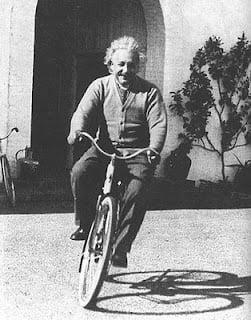 There is an urban legend that the great German-born inventor, Albert Einstein, dreamed up his Special Theory of Relativity while riding his bicycle in circles, arms crossed, as he smoked his pipe. It was said that this was his favorite way to ponder a problem.
There is an urban legend that the great German-born inventor, Albert Einstein, dreamed up his Special Theory of Relativity while riding his bicycle in circles, arms crossed, as he smoked his pipe. It was said that this was his favorite way to ponder a problem.
While most regard Einstein as a scientific or mathematical genius, he was actually a creative genius. He let his imagination rule his thoughts. Mr. Einstein liked to fly by the seat of his pants. He was a pantster. What’s a pantster, you say? It’s a person who creates, or writes in our case, by sitting down and simply letting it pour out, with no regard for anything but imagination.
The opposite of a pantster is a plotter, someone who is methodical, deliberate and structured in their creative process. Before any writing is done, a plotter carefully determines what he will write, in what order and manner. So, which is better? A plotter or a pantster?
Pantster: Your strong suit is going with the flow. You may want to set aside certain times/hours of the day when you feel most creative. Put a “genius at work” sign on the door and a brew a cup of coffee or tea. Make sure you don’t stop the writing process to correct any of your manuscript. There will be plenty of time for that during edits.
Wenger and Poe, authors of “The Einstein Factor,” cite Friedrich Schiller, famed German writer, “You reject too soon and discriminate too severely. It hinders the work of the mind…if the intellect examines too closely the ideas…pouring in…at the gates.” Schiller suggests deferring critical judgment for a later time.
Plotter: Do you need to know where you’re going before you start? If your genre is complex, like mystery, you may need to keep a close eye on the plot threads, so they are all sewn in by the end of the story. Otherwise, it is wasted effort.
For the plotter, a spider web story diagram may be helpful. On a large page, write your main topic or plot line and circle it. Draw four lines, one on each side of the circle. Write four scenes at the end of the four lines and circle them. Draw a line from each of the four scene circles and write four sub-topics or scenes. Continue as needed.
An index card/bulletin board system is preferred by other plotters. You may want to write character information, scenes, plot and sub-plot notes, dialogue, setting and background on cards. These can be arranged in chronological order on the board, which should be placed in your writing area to reference as needed.
Don’t let all that discipline and structure affect your creativity. According to Wenger and Poe, “Our subconscious minds spew forth streams of images, hunches, and subtle perceptions almost 24 hours a day, many of them charged with insight and premonition…most of us fail to heed these messages…first impulse was to squelch it…the vast majority of people squelch their most profound insights without even knowing it…this defensive reflex…blocks us from achieving our full mental capacity.”
Whether you are a pantster, a plotter, or somewhere in between, you need to keep entertaining the creative genius that inhabits our souls. Einstein’s imagination flowed when he rode his bike, something that reminded him of his childhood in Germany. Perhaps our own organic creativity could be enhanced by allowing our thoughts the freedom and space to play.
“Life is like riding a bicycle. To keep your balance you must keep moving.”–Albert Einstein, inventor (1879-1955)


I am a panster. It takes too much time to plan details. When I start writing, I don’t stop until I feel I need to. It always surprises me how much I can write in one sitting. When I need to tend to day-to-day things; and if I don’t go back and continue writing, sometimes it’s hard to pick up where I left off.
The only exception to this is that I try to get a background on some characters before I continue writing. That helps me to put in the little details that could help readers understand those characters.
Okay, so I misspelled pantster. Got in a hurry. lol
😀 Pantster all the way! I try to do some plotting though…just for my own sake. 🙂
I’m more of a pantster, but there are times during the process (usually the middle of a story) that you have to plot a little bit to be sure you’ve resolved things once you get to the end. Writing by the seat of the pants is much more fun, though!
I like to think of myself as a plotter. I guess for me there has to be a method to the madness, a place where I’m going. Usually that means one of two things: how the story will end or what the middle after the beginning is established. I remember reading about an author in a book who said that each book must have a beginning, middle and ending. The book was clearly joking but there is some truth in that for me. Although I hope it is not immediately obvious to the person reading the book I write, I like to think that there is underneath a kind of underlying structure and order. I don’t know. I hope I haven’t offended anyone.
Thanks for your comment, Jennifer! No offense taken on my end. I am a plotter myself. Although my soul is creative, my mind is organized. I outline the framework of a piece and then fill in around it. Sometimes, the story takes itself in a different direction, so I have to recalculate when that happens. To each his own!